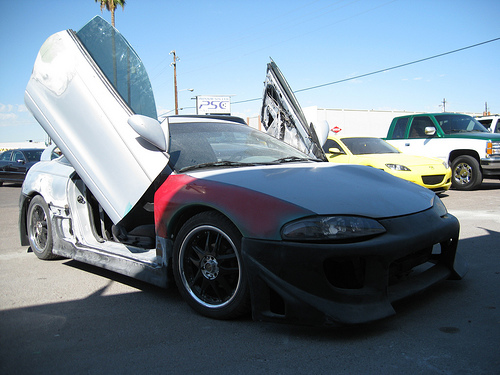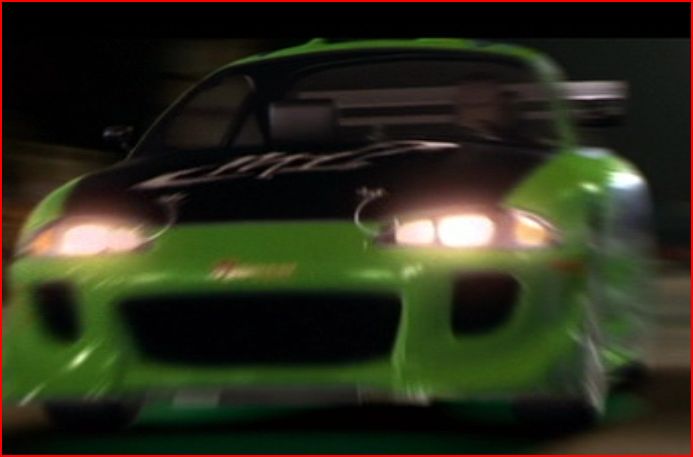|
When you hire UMODS to build you a complete application you are given the time and effort spent into researching your build and making sure that the goals you set are reached. May it be a certain 1/4 mile time, show car, street car, drift, etc...,. You will be provided a very detailed document describing your build steps and parts. Actual numbers, figures, pictures, and prices. An additional feature of our service is inside access to performance parts at wholesale direct from the suppliers we work with. If we don't supply it we find it and make sure you pay the least amount for it. The guess work is taken out of tricking out your car. We can even arrange custom fabrication of just about anything you are looking to have done.
The application is documented in a easy to follow form that is custom made just for you. We also document your rides current status, the stock specs of your year, make, and model. This called your current progress sheet that shows how far you have come. Once you have completed your application it serves as a before and after of you build.
So to recap:
A complete "background check" on the vehicle of your choice. A suggested route of modification that is matched to the vehicles specs and area(s) of accelement. One per application additional vehicles can be added for a small fee.

Dimensions
Exterior
Length: 172.4 in. Width: 68.3 in.
Height: 52.8 in. Wheel Base: 98.8 in.
Ground Clearance: 5 in. Curb Weight: 2842 lbs.
Interior
Front Head Room: 37.9 in. Front Hip Room: 55.1 in.
Front Shoulder Room: 53.1 in. Rear Head Room: 34.3 in.
Rear Shoulder Room: 51.2 in. Rear Hip Room: 47.2 in.
Front Leg Room: 43.3 in. Rear Leg Room: 28.4 in.
Luggage Capacity: 16.6 cu. ft. Maximum Seating: 4
Performance Data
Performance
Base Number of Cylinders: 4
Base Engine Size: 2 liters
Base Engine Type: Inline 4
Horsepower: 140 hp
Max Horsepower: 6000 rpm
Torque: 130 ft-lbs.
Max Torque: 4800 rpm
Drive Type: FWD
Fuel Data
Fuel
Fuel Tank Capacity: 15.9 gal.
EPA Mileage Estimates: (City/Highway/Combined)
Manual: 20 mpg / 30 mpg / 23 mpg
Range in Miles:
Manual: 318 mi. / 477 mi. / 365.7 mi
Overview
The second generation car maintained the market focus of the 1G car, but had a major update in styling and had different engines between trim levels. New to the line was a convertible model, the Spyder, introduced in 1996. The convertible was available in two trims: the GS and the GS-T. The first is powered by the non-turbo 4G64 engine, and the latter by the turbo 4G63 found in the GS-T (turbo) and GSX (all-wheel-drive) hardtop models. There was no convertible model powered by the Chrysler 420a.
The turbocharged engine option continued as the 4G63, but was modified for more power as compared to the previous generation (210 hp vs 195 hp). The non-turbo engine had 2 different engines depending on the market they were produced for. The US version engines were producing 140 hp, found only in the hardtop RS and GS trims, was a modified version of the Chrysler Neon engine, manufactured by Chrysler and delivered to and installed at the Diamond Star Motors facility. The Europe version engines were naturally aspirated 4G63 with 141 hp. A limited number of 2G units were delivered with a 2.4L naturally-aspirated engine provided by Mitsubishi.
The Talon was discontinued in 1998 along with the rest of the Eagle line because lack of sales over previous years, leaving only the Eclipse on sale for the 1999 model year.
Trim levels
The Eclipse was available in seven trim levels: Base[Only available in 1996.5 (mid-model year)], RS, GS, GS Spyder, GS-T, GS-T Spyder, and GSX.
Second generations (1995–99) cars:
Eclipse: Base FWD model equipped with a 140 hp 2.0 L
16-valve DOHC Chrysler 420A engine
Eclipse RS: Equipment Upgraded FWD model equipped with a 140 hp 2.0 L 16-valve DOHC Chrysler 420A engine
Eclipse GS: Equipment upgraded FWD model equipped with a 140 hp (100 kW) 2.0 L 16-valve DOHC Chrysler 420A engine
Eclipse GS Spyder: Convertible FWD model equipped with a 141 hp (105 kW) 2.4L 16-valve SOHC Mitsubishi 4G64 engine
Eclipse GS-T: Hardtop FWD model equipped with a 210 hp (160 kW) turbocharged 2.0 L 16-valve DOHC Mitsubishi 4G63 engine
Eclipse GS-T Spyder: Convertible FWD model equipped with a 210 hp (160 kW) turbocharged 2.0 L 16-valve DOHC Mitsubishi 4G63 engine
Eclipse GSX: AWD model equipped with a 210 hp (160 kW) turbocharged 2.0 L 16-valve DOHC Mitsubishi 4G63 engine
The models had different trim accoutrements:
Base - No tachometer, standard antenna, No rear defroster, no driving lights, 14" steel wheels with covers or center caps
RS - Tachometer, 14" alloy wheels, optional spoiler
GS - Power antenna, driving lights, cruise control, body coloured door handles, 16" alloy wheels, lower body cladding, spoiler, rear windshield washer
GS Spyder - Power antenna, driving lights, cruise control, body coloured door handles, 16" alloy 5 spoke wheels, lower body cladding, spoiler, double tipped stainless steel exhaust
GS-T - 16" Alloy 5 spoke wheels, Grey painted panel around lower body paneling (1999), larger spoiler (ONLY on 1997–98), double tipped stainless steel exhaust
GS-T Spyder - 16" Alloy 5 spoke wheels, double tipped stainless steel exhaust
GSX - 17" wheels after 1997, 1995–96 cars had 16" alloys, Grey painted panel around lower body paneling (1999), double tipped stainless steel exhaust, larger spoiler (ONLY on 1997–98),
1997-1999 Mitsubishi Eclipse convertibleA minor style revision was applied for the 1997 model year. The front grille opening was given a more aggressive profile. The headlights were given a sharper slant on the inner edges, and the previous all-chrome fixture interior changed to a black interior with chrome reflector inserts. The driving lights were revised from a reflector type to a smaller projection type. The rear bumper cap was altered and had the reverse lights restyled and moved out into the bumper fascia, away from their original central position by the license plate bracket.
A special version of the Eclipse, called the "GS Tenth Anniversary Edition", was sold at the end of the 1999 model run with unique 16-inch rims supplied to Mitsubishi by OZ Racing. It also included the leather interior package, accented exhaust exit, and hoop-style spoiler that were normally offered on some turbocharged models. The special edition package was only offered with the 420A engine.
A unique version of the 2G Eclipse sold in some European countries. It used a normally-aspirated Mitsubishi 4G63 motor, similar to what was available in the 1G, unique sideview mirrors, and unique amber rear turn signals.
The Talon was available in four trim levels: Base, ESi, TSi and TSi AWD. The Eagle Talon saw its production end in 1998 when Chrysler shut down the Eagle sub-brand, although the Dodge Avenger and Chrysler Sebring continued to be sold in variations that used the 420A engine and many of the 2G Eclipse/Talon interior components.
Talon Base: equivalent to Eclipse Base
Talon ESi: equivalent to Eclipse RS & GS
Talon TSi: equivalent to Eclipse GS-T
Talon TSi AWD: equivalent to Eclipse GSX
There were similar alterations to the styling of the Talon as there were for the Eclipse.
Drivetrain
The basic driveline layout of the Eclipse is a transverse-mounted 4-cylinder Chrysler 420A, Mitsubishi 4G64 or 4G63 engine. The Mitsubishi motors are mounted in the same orientation as for the 1G cars. The 420A-powered cars had the engine mounted on the right side of the car,and further back in the chassis. AWD models had a similar transmission to the 1G car. The 2G GSX also had a stronger carrier/differential when equipped with the limited slip option.
Motor
All motors are 4-cylinder gasoline engines. All have iron blocks with aluminum cylinder heads. The 4G63/4G64 engines retain the balance shafts for smoother operation, while the 420A does not use them. The 1995-1999 turbo engines were given an increased compression ratio of 8.5:1, up from 7.8:1, and a smaller turbo, a Garrett T25 in place of the previous Mitsubishi TD04-13G (automatic cars) and TD05-14B (manual cars). This was done to minimize turbo lag, which was an undesirable trait for mass-market appeal in the US.
The 4G63 engines found in 1990-1994 models have a 60 mm throttle body compared to the 1995-1999 MY's 52 mm. The intake ports on the head and runners of the intake manifold are also larger. They also have larger crankshaft bearing journals to allow better lubrication.
The first-generation 4G63 head with its larger intake ports appears to offer better performance potential than the second-generation head due to its increased flow capacity in stock form. However, the second-generation head can be ported to increase the size of its intake ports similar to that of the first-generation head. Furthermore, the smaller ports provide greater velocity which aids in cylinder filling, and thus, as is the case with any head porting, port size is a compromise between air flow and air velocity.
A complete write-up of your current vehicles state, includeds any pictures you may have taken already, pictures can be arranged to be taken with-in the local area. The vehicle profile will be submited to online car communitys for online viewing of your of builds progress.

During your consultation we will review what type of goals you have set for your ride. This step is critical to insure your build application is made to fit the route you have chosen to take. Three key factors:
Performance
Styling
Intended usage of vehicle
A complete project build write-up to include everything needed to do the build:
Pictures
Prices
Specs
FAQS generally associated with install/parts
The format is easy to follow and can be provided in electronic format or hard copy. A additional fee is given to cover cost of faxing copies. Included is a overview of the builds goals that were set durring the consultation. Information about the products sources are given, to address any questions you may wish to address directly with them. If applicable a optional direction of modification route could be offered. (i.e. you may have chosen to build a drift car but the application may be more suited for a time attack or ralley event).

Access to my product listing after your application has been completed, if you ever change your mind about a route ,or a certain componets, and wish to add to the build you will have methods of doing so.
A flat fee of $20 for the research and application build.
$10 for creating and posting your profile information to various car communities.
$5 per extra build route and background check per vehicle year, make, and model.
Complete Application Builds Done For You
For the ultimate in application builds, have a complete application build done to meet your specs as before. Now allow us to do everything for you, from ordering parts, installing, arranging installs, body work, engine work, etc..., the works. You just relax in the A/C with the game on, or hit a extra round at the golf course. We don't make a move unless you approve it, so you stay in the loop and call the shots. Our service is custom to fit your budget and time concerns. If you require to break the modifications up over a period of time we are more then happy to meet your needs. Durring your consultation we will make sure to address your needs.
The fee's for this service are a direct reflextion of the required amount of effort to complete the build. The fee is spoken on only after a complete application has been completed. If you have any questions about this please feel free to email me at UMODS@LIVE.COM
FREE CONSULTATION TODAY |
| |
| |
| |
| |
|
|